The Kizer Gemini is also called Kizer Ray Laconico Gemini named after its designer Ray Laconico. It is based off of his popular Jasmine Model and is an EDC that is smooth to flick and fondle with.
Like other Kizer knives, Gemini also has different variants. Each variant’s prices also differ depending on their materials, built and features. The one we are reviewing today is Kizer Gemini Titanium Gray Ki3471 (3.125″ Stonewash).
Kizer Gemini Review
Kizer Gemini is a standard 7.25” folding knife with a 3.125” blade length and a weight of 3.65 oz. It has a drop point CPM S35VN steel blade with titanium scales, flipper deployment and frame lock mechanism. The blue anodized screws with a small lanyard hole make its compilation fine and shine.

Key Specifications of Kizer Gemini
First Impression of Kizer Gemini
Kizer Gemini came in a premium packaging like all its knives do. The knife looked top class right out of the box – visually appealing with top-notch features.
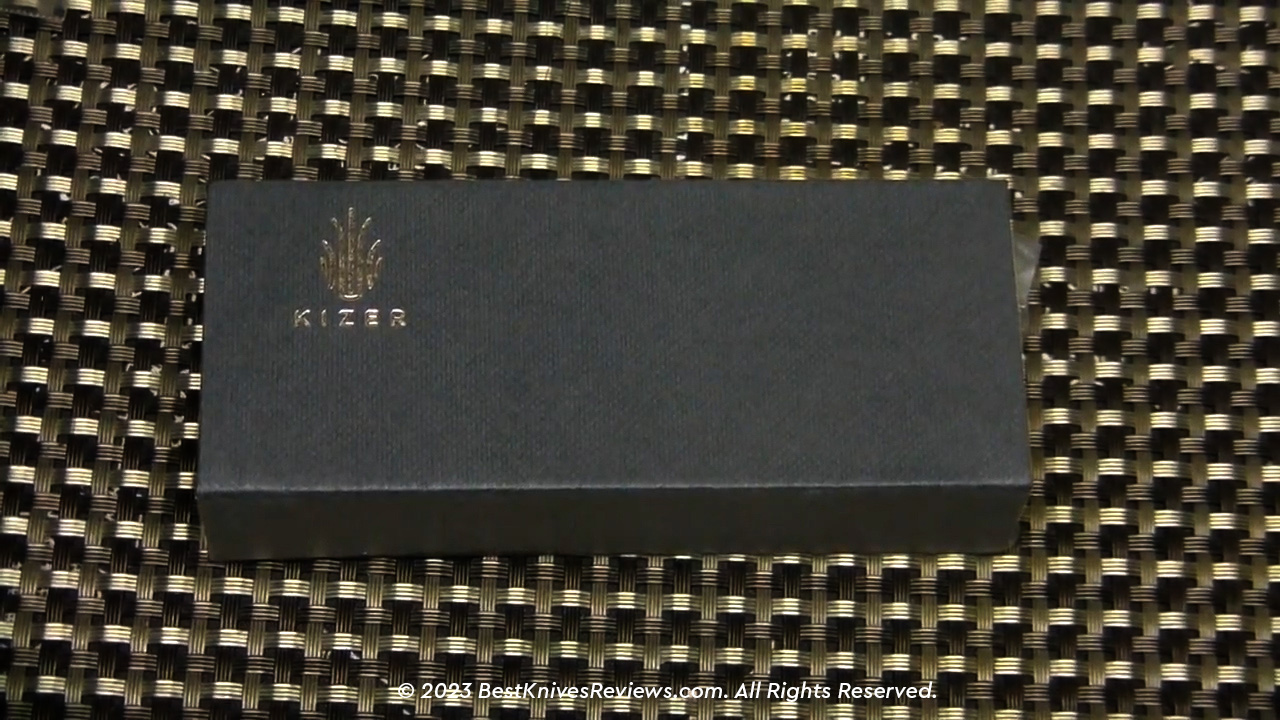

The handle finishing looked great with zero scratches or machine lining. The anodized screws were impeccably and neatly screwed making the knife sit perfectly straight and perpendicular.
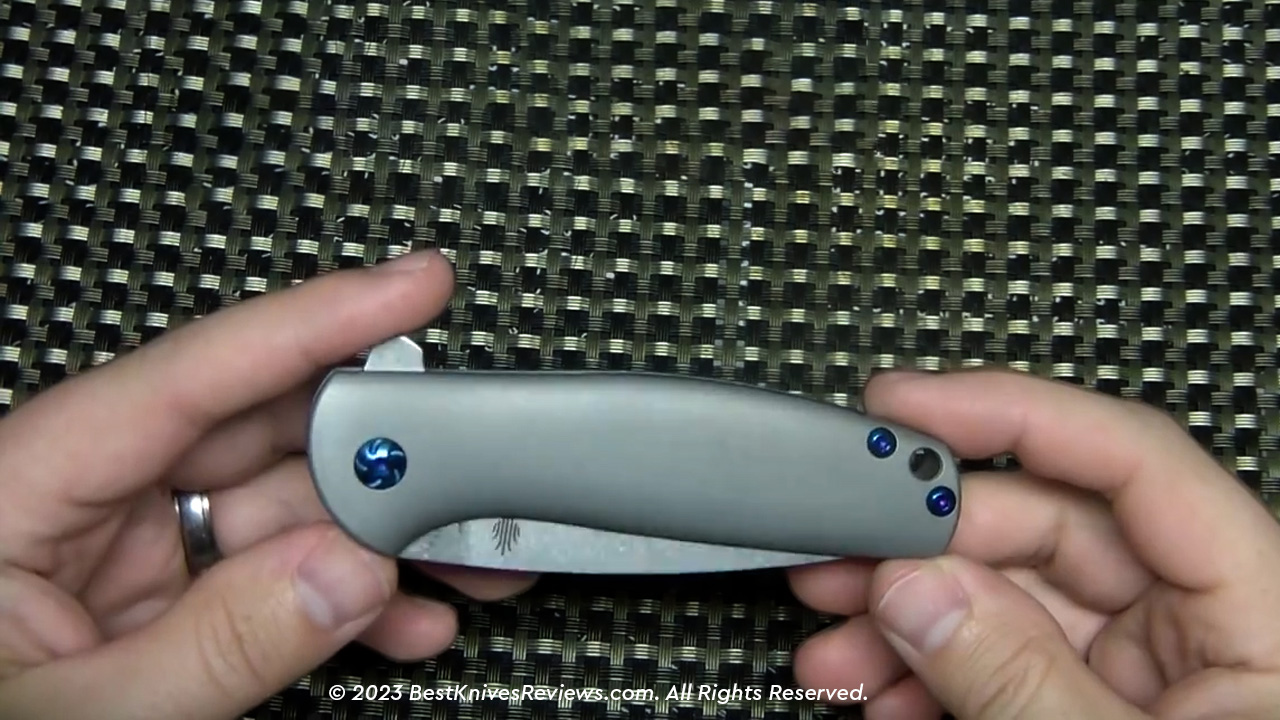
Everything on this knife screamed luxury and smoothness. The lockup and deployment was as smooth as expected. There was absolutely no blade play in the lockup and deployment. The flipper tab was smoother than the lockup itself. The detent and the ball-bearings were perfectly placed and shaped on this knife. The blade flies right out when deployed and the grip is also comfortable and smooth.
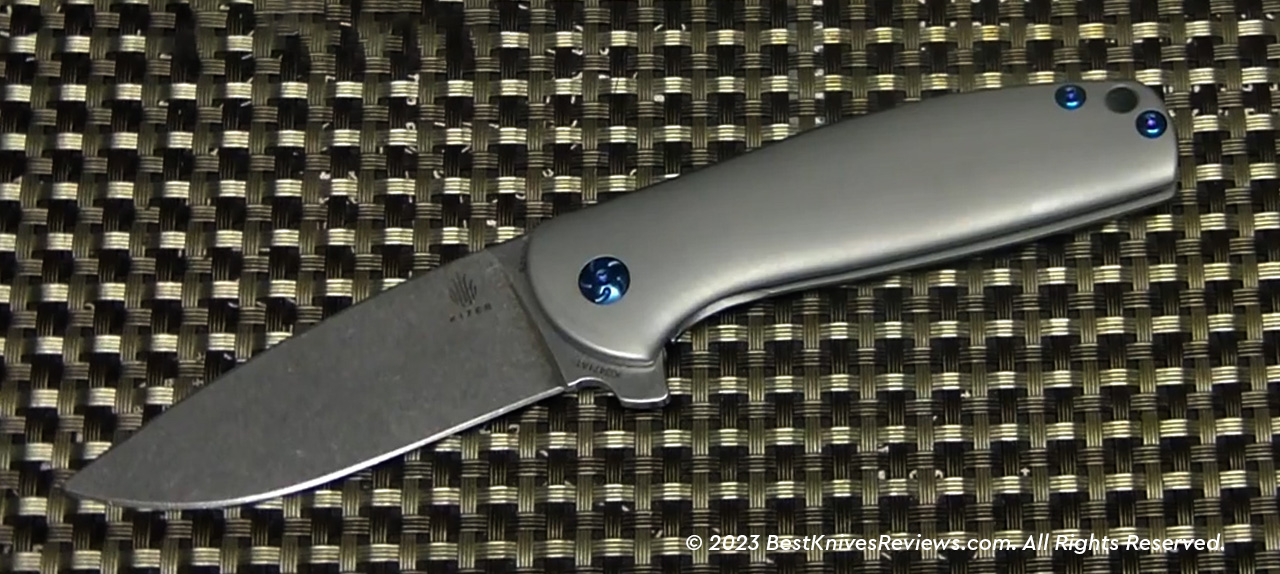
You can really choke up the knife however you want from front, back, and center. The chamfering and finger choil plays an important role in how you hold the knife and protects your fingers from sliding through, especially during rough use.
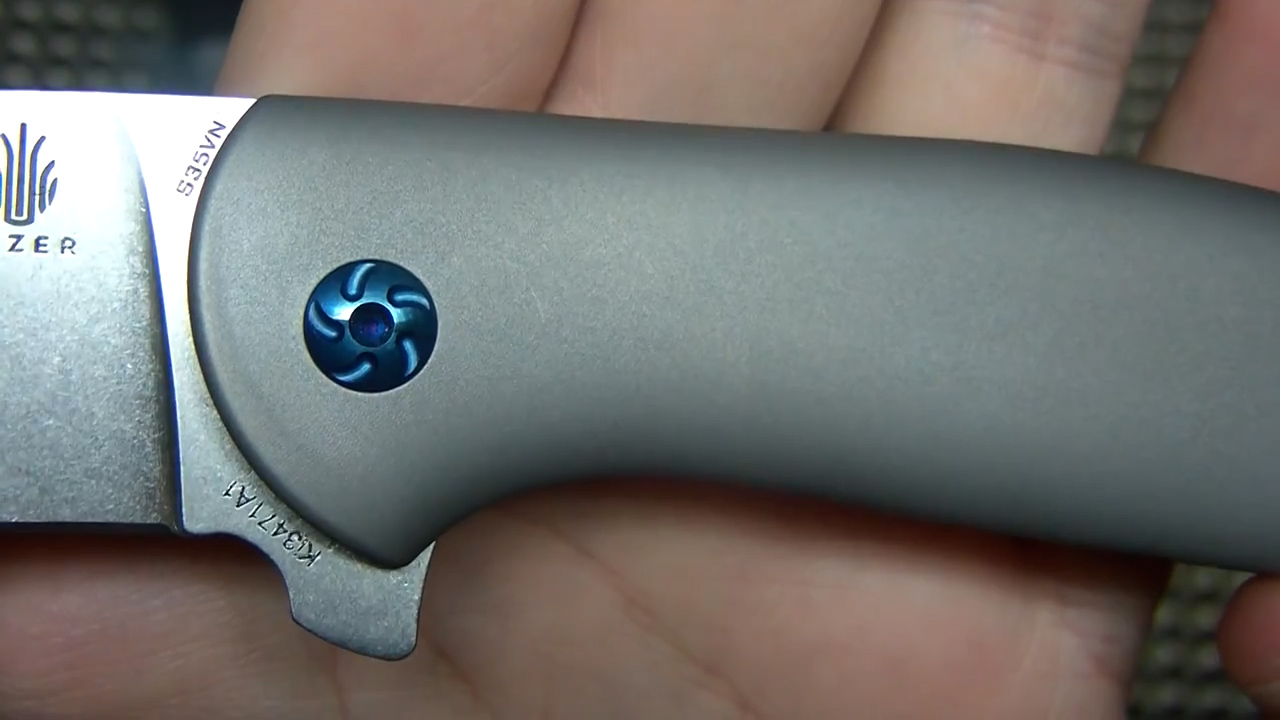
The inscriptions are also very fine and visible right out of the box. Price wise, this knife came in a good deal at $119. It is a high-end Chinese knife that compares well to other high-end US made knife brands like Sebenza, ZT 0900, and Spyderco Techno. So this price is really not much for a knife of this caliber, and so far we do not find any problems with it.
As far as the pocket clip is concerned, we really like its finishing and a pop of anodized light blue, which enhances its appearance. It also does not get in the way of holding the knife and is just the right size for a knife of this knife. Everything on this knife comes together nicely and compliments each other.
Blade of Kizer Gemini
The blade of Kizer Gemini has an almost perfect shape. With the perfectly angled drop point and full-flat grind, the gentle spine curve turns towards the tip on a symmetrical cutting side. The flat grind combined with the drop point perfectly complement each other, making it a utility cutting tool that is also aesthetically pleasing.
Unlike the variants that came before this one, Kizer etched its designer name “Ray Laconico’ right at the base of the blade stock thickness towards the spine. It is a swell placement because it looks artistic. The same way, it places its model number on the flipper side, with the blade material on the other side.
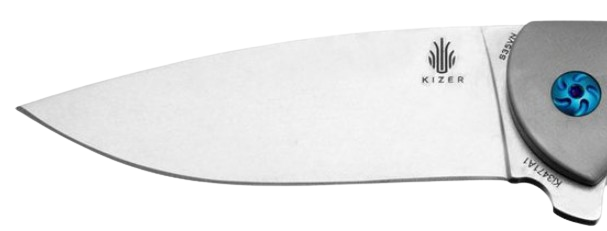
The formidable and premium CPM S35VN is a popular choice for a pocketknife and for good reasons. It is corrosion and wear resistant, has a fine edge and edge retention and just the right hardness level. It is a great material to use on pocketknives and it serves all EDC functions without haste.
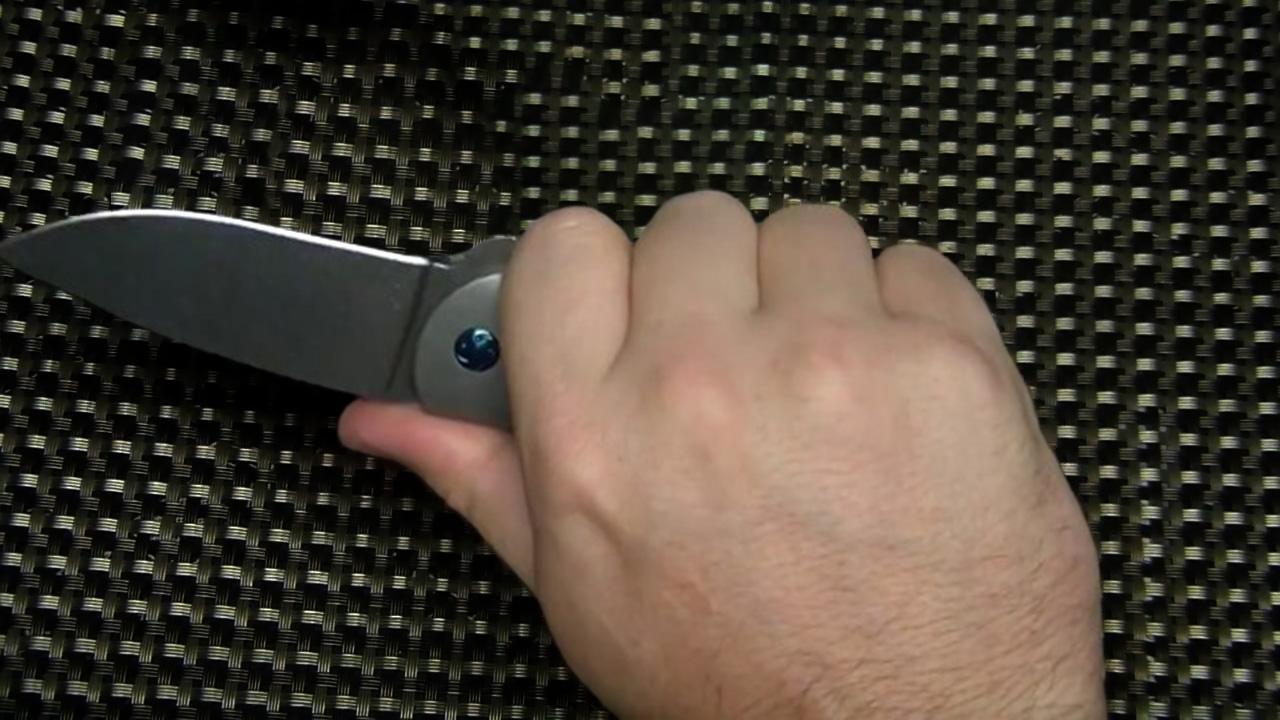
CPM S35VN rating from 1-10:
| Edge retention = 7/10 | Corrosion resistance = 7/10 | Ease of Sharpening = 5/10 |
It is made from a much finer powder metallurgy grain structure with tiny quantity of niobium than its predecessor S30V. Its toughness and ease of sharpening also improved. It is also highly stain resistant. You can leave it in acidic compounds for some time but not too long. It will eventually wear. So maintenance is equally necessary.
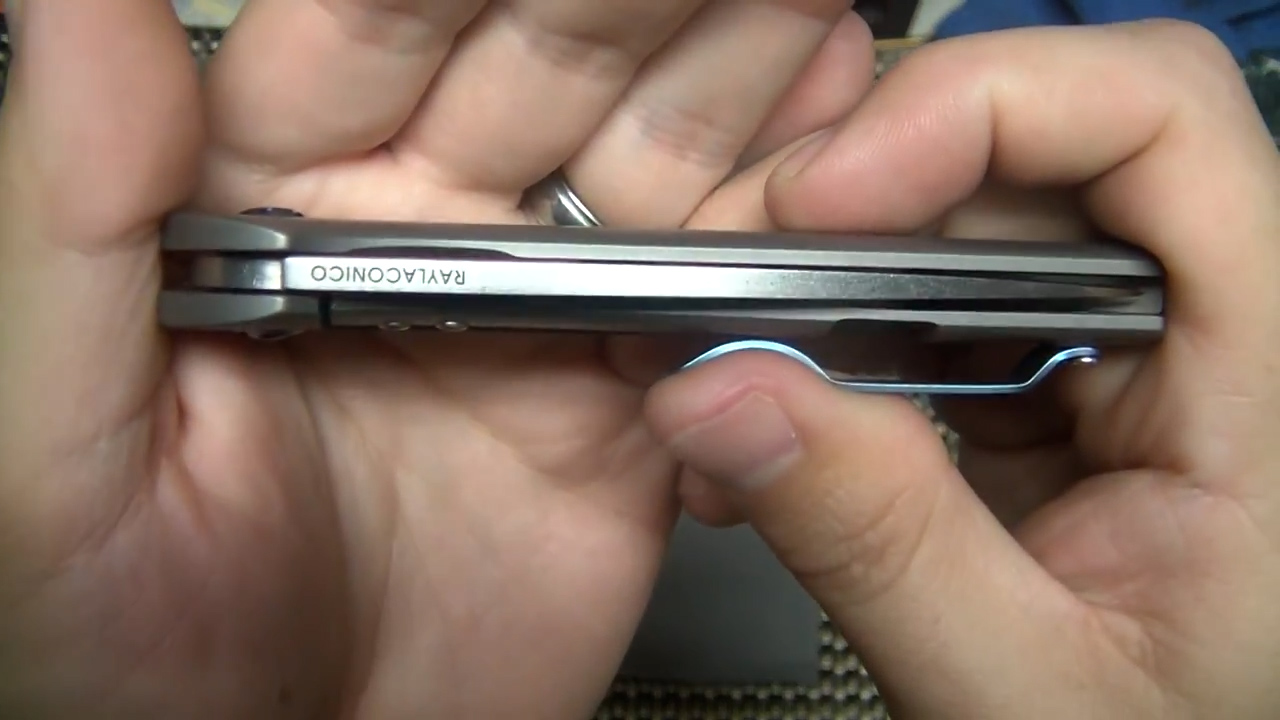
The polished stonewash does wonders to this blade. It does not show any visible scratches right out of production, and has visible grind lines. It is much better than the shiny satin finish that will show scratches and lines right out of production.
Handle Ergonomics of Kizer Gemini
The design of Kizer Gemini’s handle is pretty simple with contoured edges and sculpted scales designed with precision. The Gemini features 6AL4V titanium handle that is strong, light and corrosion resistant. But they are relatively expensive and prone to scratches. But it is lightweight metal alloy and is very rust resistant. It is a little heavier than aluminum scales but the machining on it is finer.
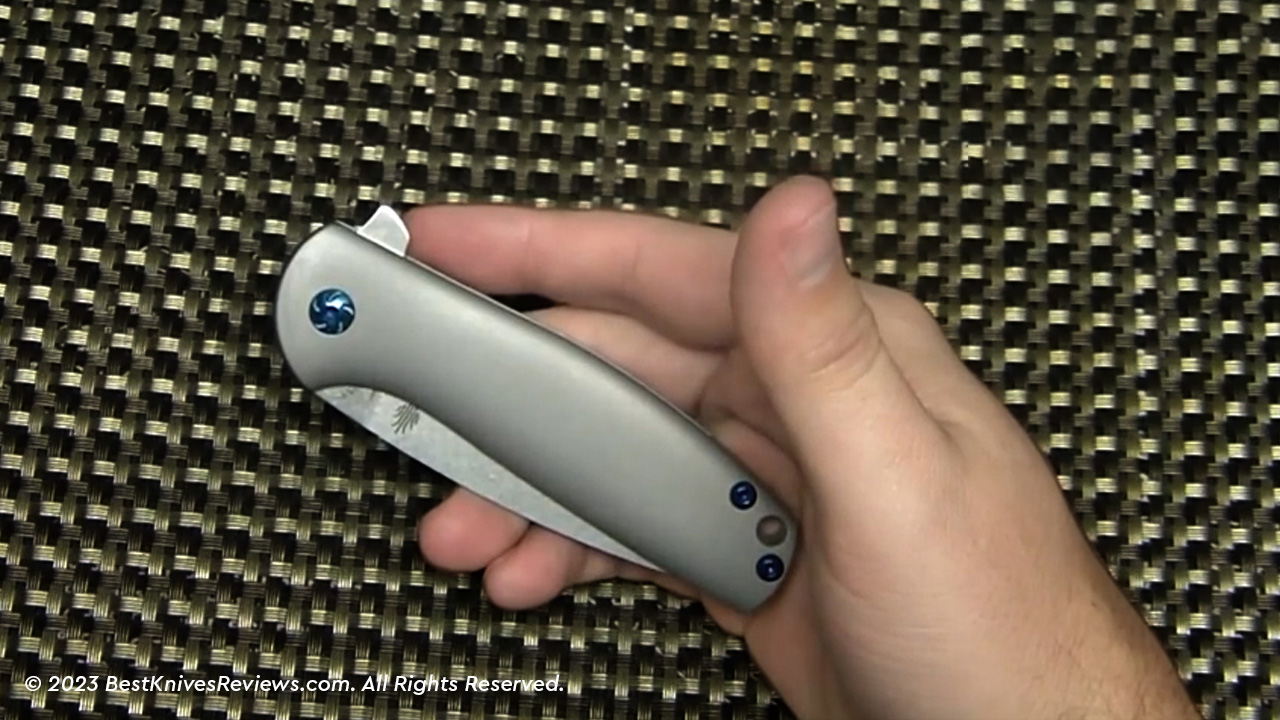
The scale slabs are completely rounded and chamfered to prevent any rough spots and edges. It makes the knife comfortable and soft to hold, yet sturdy. That makes the knife ergonomically friendly. The swell that protrudes from the handle mid part and straddles along the edges fills your palm when holding it.
Another good thing about the scales is its shape. It is not totally straight and not completely bent. It takes the shape of the knuckles and palm when holding it, making it functionally sound. The finger choil at the bottom spine also helps prevent your finger from sliding off towards the blade. It gives the hand much needed freedom to use the knife for an extended period.
The gray stonewash also does a good job of hiding signs of wear and tear. It also does not show finger marks or sweat marks, which makes it more durable.
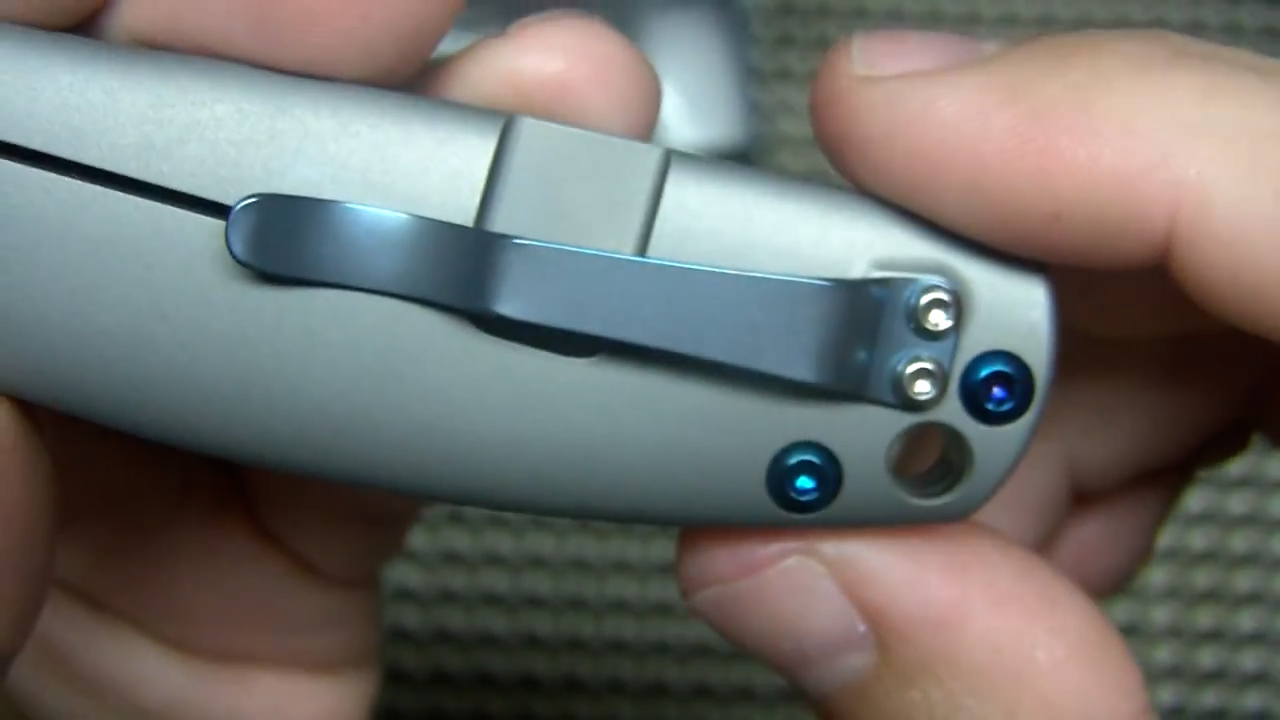
The light blue tip-up carry pocket clip clips well in the pocket. Its finishing is nice and has a good appeal.
The lock bar cut out is placed in a way that it does not coincide with the palm when in use. And its thin geometry provides it a pleasing aesthetic and a stout look. The handle profile is simple yet comfortable.
The blue anodized pivot is pleasing to look at. The hardware with the caged ceramic ball bearings, ceramic detent ball and the adjustable stainless steel lock bar with a stop pin is attention to detail. All these things fit perfectly together with a titanium partial backspacer. It also makes the knife’s deployment and lockup smooth.
Deployment & Lockup of Kizer Gemini
The detent of Kizer Gemini is what makes the deployment and lockup smooth. It holds the blade closed on the lock bar with fast deployment with just the touch of a finger on the flipper. The flipper tab is smooth yet strong. It may be relatively small and its location is above the pivot instead of below or parallel to it. But it is well-placed that enables just the right amount of pressure to flick it open.
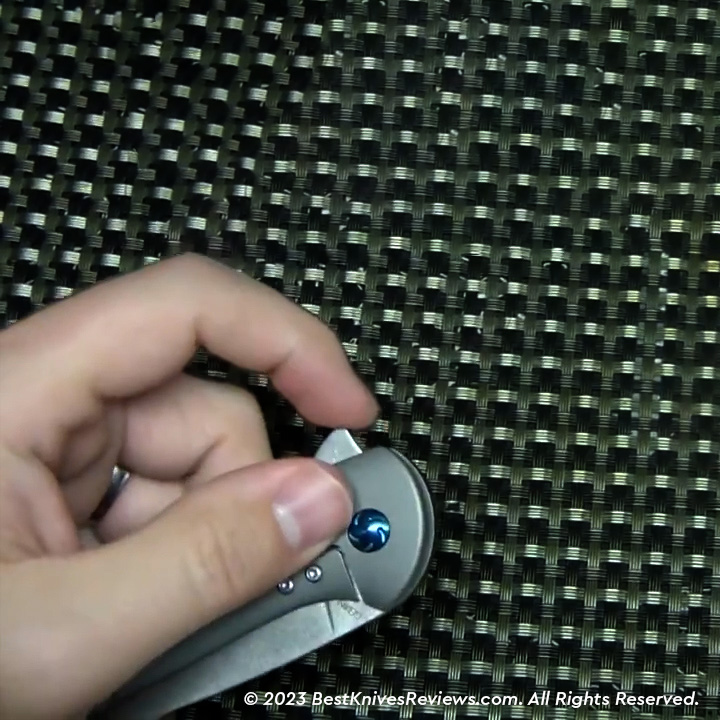
The frame lock uses the handle or the frame to lock the blade in place instead of the liners in a liner lock. Its designer, Chris Reeves, named it integral lock where the ball detent mechanism takes place into part of the handle with a loaded spring that shifts just like in a liner lock.
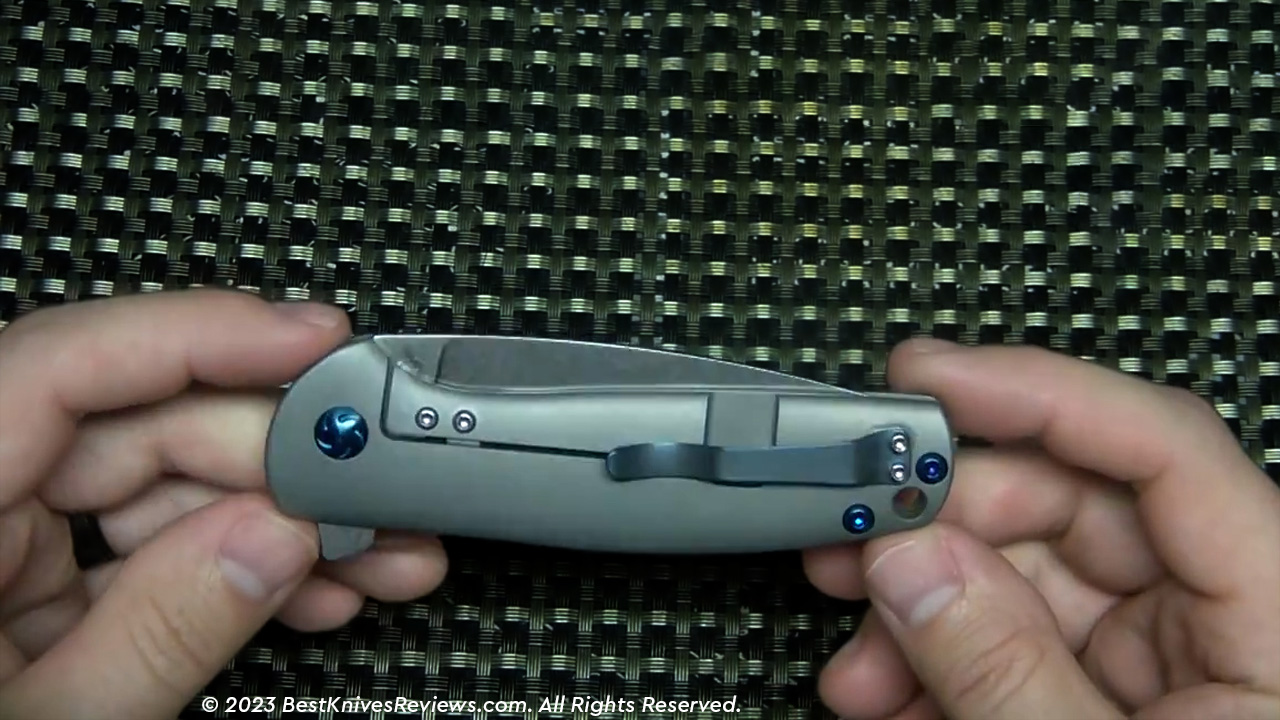
When you flick the blade open, it reaches the external stop pin, making the lock bar squeeze shut with the steel lock bar insert contacting with the blade. The lockup is pretty strong with almost zero blade play. But if you keep flicking it frequently, your thumb may go sore. So the mechanics of the lockup balances precariously on Gemini. People who are less prone to opening and closing the knife will like this addition. Those who do it frequently may not like it.
Field Test of Kizer Gemini
Kizer does an excellent cutting job when it comes to EDC tasks. It slices and chops fruits and vegetables flawlessly. It cuts and slices through paper and cardboard effortlessly. It is ergonomically superior with a blade that has a high edge retention. We also love the full-flat grind because that makes it easier to sharpen. The finger choil made longer cutting tasks more comfortable without biting into the hand. As long as the blade is shaper, it requires minimal hand effort and wrist flick and twist. That also puts less strain on the hand.
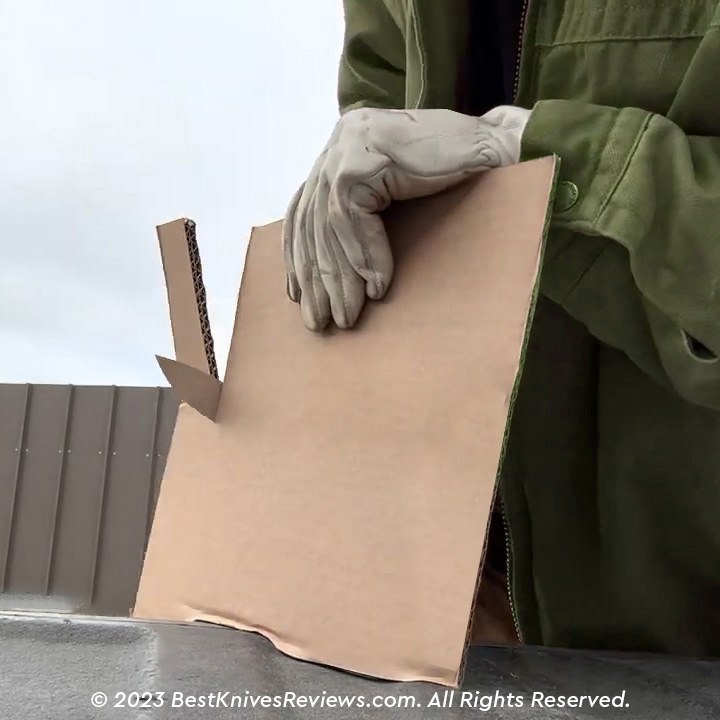
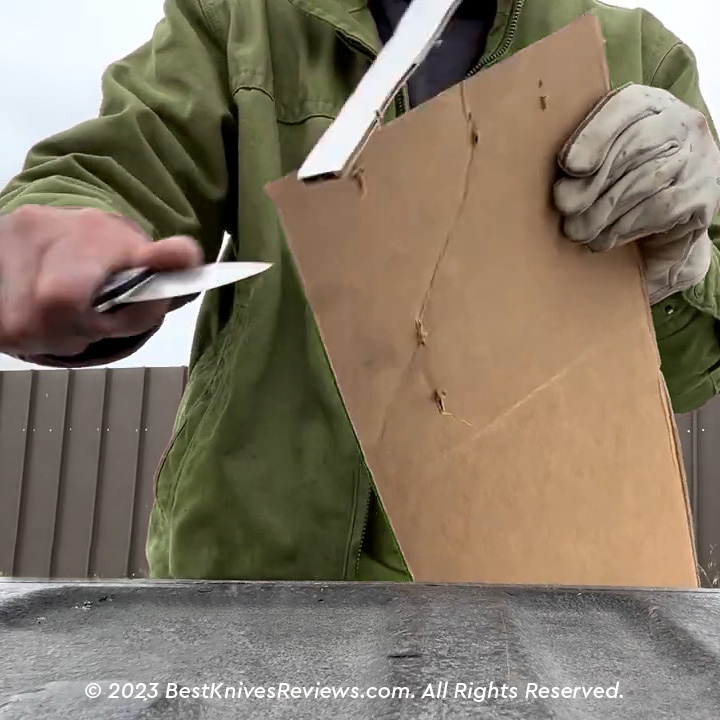
We were able to slice through a huge sheet of cardboard paper with exceptional ease. The handle was as easy to hold in the cold, with gloved and sweaty hands. The dirt and bits and pieces of cardboard did not get in the way of the task’s speed and efficiency.
We also tried cutting different kinds of cardboard boxes, packing materials, envelopes, tape and rope. It performed well with each items. It did not get dirty even after cutting everything during single use.


The standard blade stock thickness of 0.125” also played a positive role in the precise slicing and dicing of food and paper materials. It slices as well as a paper cutter, and the finger choil also makes it easier to make thinner cuts, so you can hold it against your index finger with ease.
The pocket clip also hung well in the pocket. Its tip-up carry prevented it from swaying either ways and the knife’s lightweight makes it easy to carry.
There was also no stain, rust, spots or discoloration on the handle or the blade. It shows the superior material quality and finishing of the knife.
Kizer Gemini vs ZT 0808
The ZT 0808 is a new release by Zero Tolerance. It has the same CPM S35VN steel blade with excellent flipper and steel lock bar with titanium frame locks. They are both a result of custom designer and are great at slicing. The ZT 0808 is a product of Todd Rexford design, who also has a reputation of making excellent custom knives. The 08080 however, has a modified drop point with better edge retention
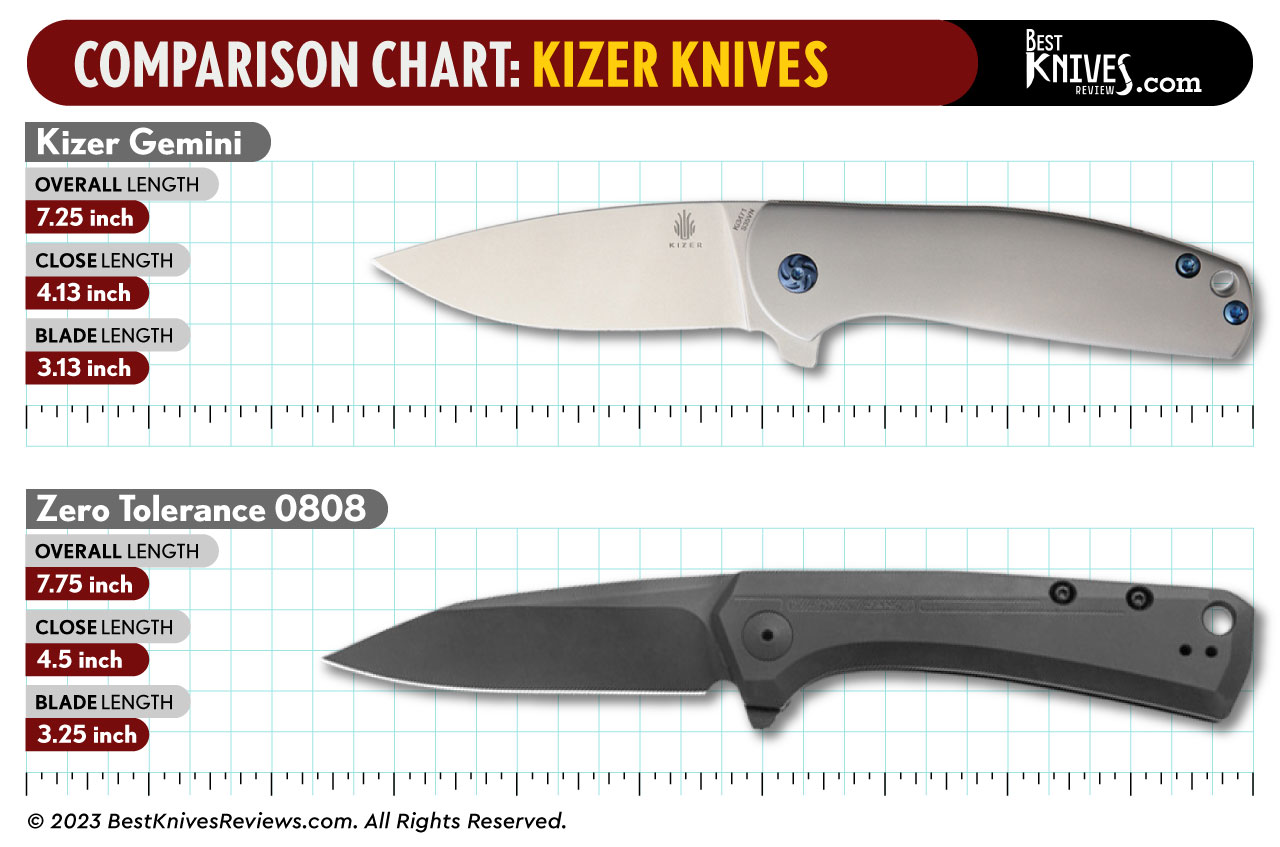
The Gemini however, is better at slicing and dicing with precision. It has a bigger belly and enables more hand control. ZT 0808’s backspacer is larger and more intrusive than Gemini, which fills the hand more with its grip.
The Gemini beats ZT 0808 with its exceptional detent and ceramic ball bearings compared to 0808’s steel detent and bearings. The 0808 is also more expensive, standing at $200.
The Gemini is one ounce lighter than ZT 0808, with a better pocket clip than 0808’s. However, both the knives are good EDCs, and the choice between the two depends on what you prioritize most in your EDC knife.
Kizer Begleiter vs Kizer Gemini
Kizer Beglieter and Gemini have a lot of things in common. They both have the same blade and handle material, frame lock and flipper deployment. They also fall under the same price range
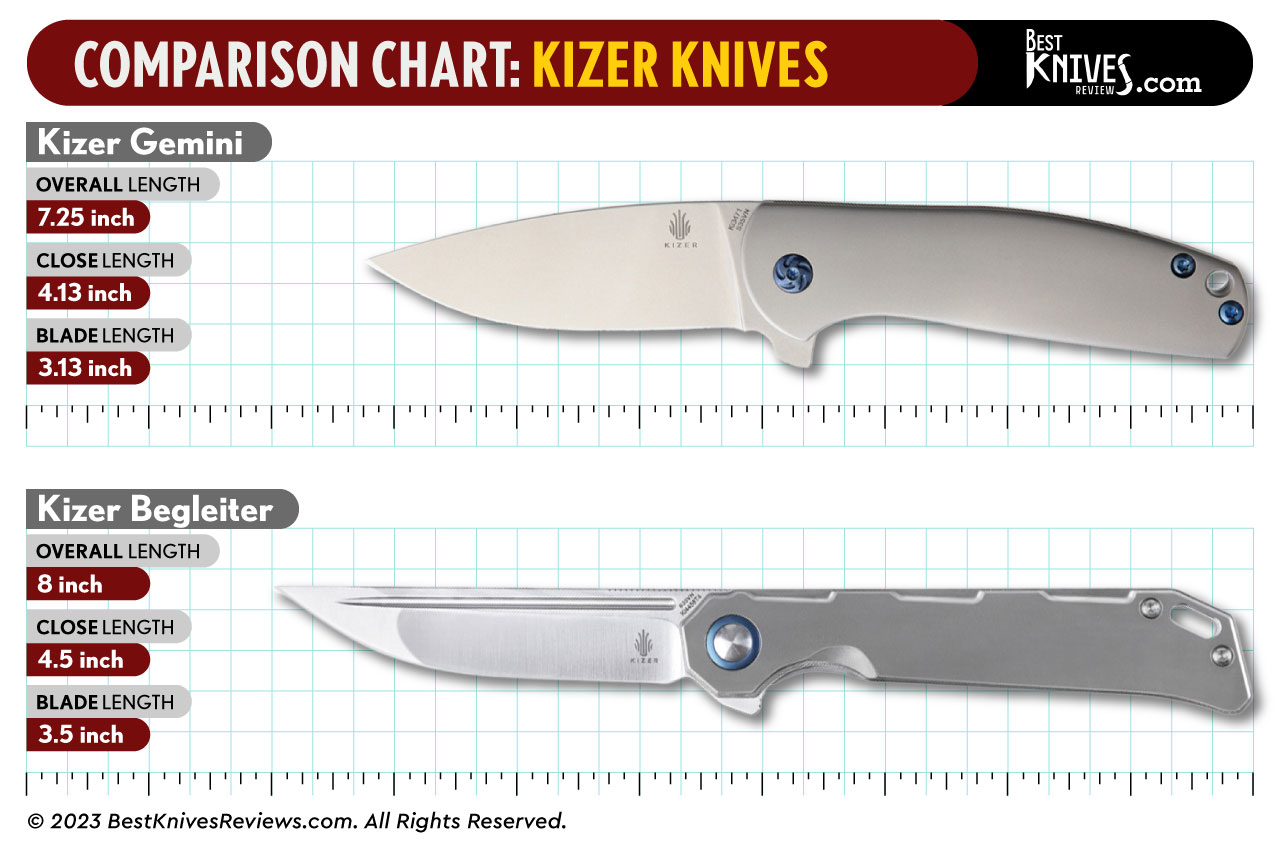
However, Begleiter is a bit larger than Gemini and has a drop point blade shape. Its handle is also more functional than the Beglieter’s. It would overcome all the minor shortcomings of Begleiter like having a good edge retention and better ergonomics with a larger finger choil. The full-flat ground stonewashed blade is easier to sharpen than the hollow grind and has an excellent ball-bearing pivot with contoured titanium handle. Although it is a bit heavier than Begleiter, but capable of working under tough EDC tasks.
Pros & Cons of Kizer Gemini
PRO’s
Con’s
Conclusion Kizer Gemini Review
We found Kizer Gemini to be an excellent folding knife through and through. Its blade, handle, ergonomics, deployment and lockup are through the charts! This knife is worth it when it comes to undertaking EDC tasks in the field. It passed its field test with flying colors and is one very attractive knife.

It costs $119, and it fits the bill. It is neither too expensive nor too cheap when it comes to its quality, features, and functionality. The thing that stood out about this knife were its detent and ceramic ball bearings that made the deployment and lockup foolproof.
Another great thing about this knife is the balance between its components, geometry, profile, along with the corrosion and wear resistance, edge retention and ergonomics. This knife fits the bill when it comes to performing EDC tasks.